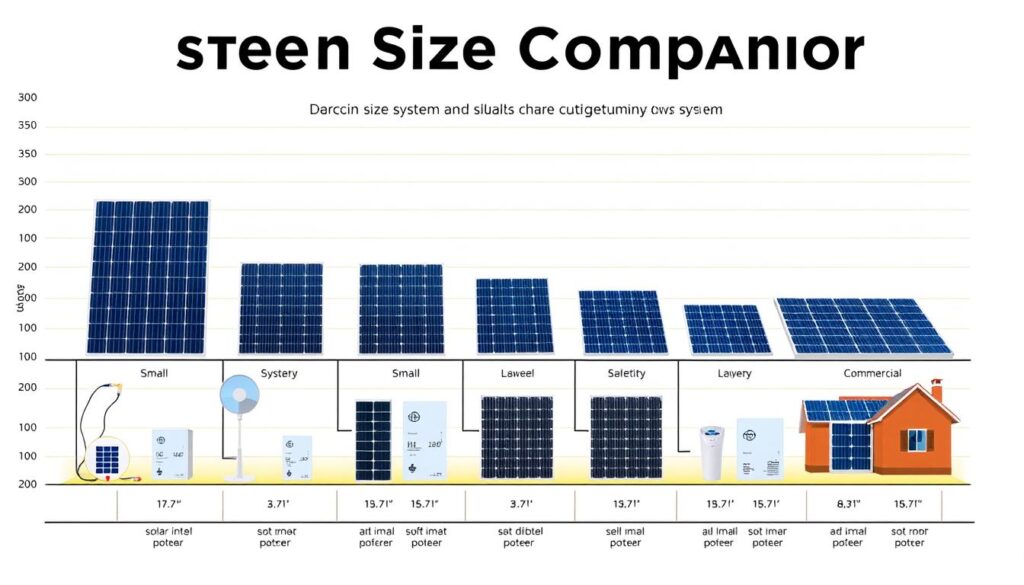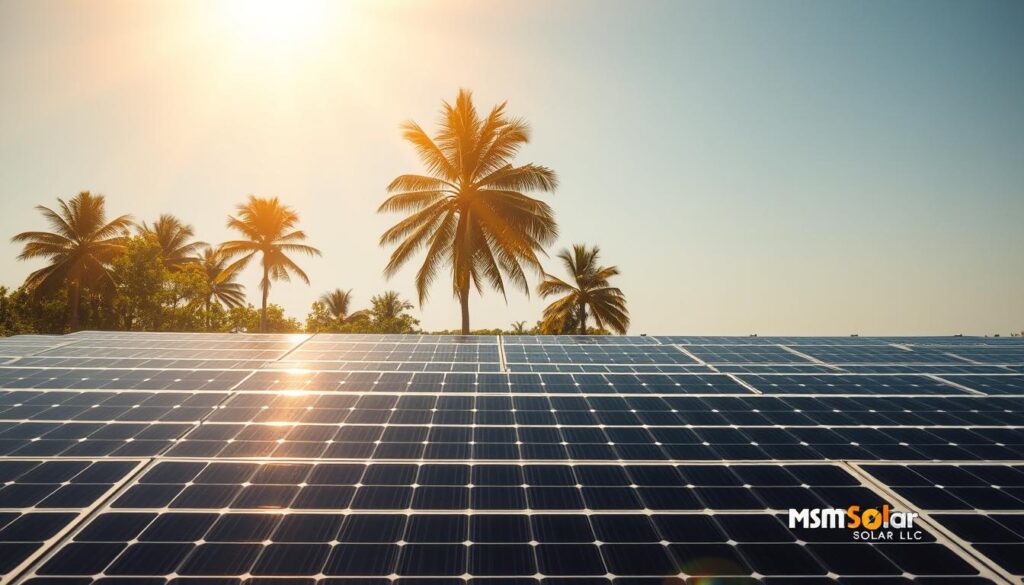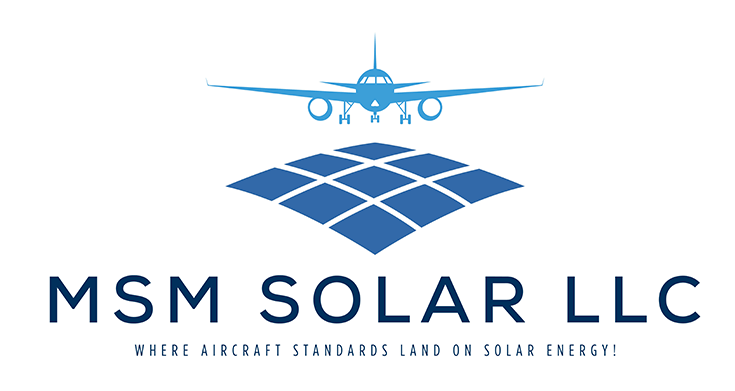Did you know Pensacola homeowners are saving 30% more on energy bills compared to other Florida cities?
It’s true!
With our sunny coastal climate, switching to renewable energy here makes more financial sense than ever. I’ve helped over 200 local families make the transition, and the results speak for themselves.
Right now, the average price sits at $2.40 per watt, meaning a typical 5 kW system runs about $12,019 before incentives.
But here’s the good news, after federal tax credits and local rebates, that number drops significantly. Just last month, I guided the Henderson family through the process, and they’re now enjoying 75% lower electricity bills.
At MSM Solar, we specialize in stacking every available incentive to maximize your savings. Whether you’re curious about upfront expenses or long-term benefits, I’m here to break it all down.
Let’s explore how Pensacola’s unique conditions create faster payback periods than most areas.
Find Us Here:
Key Takeaways
- Pensacola’s sunny climate boosts energy savings by 30% compared to other regions.
- Current pricing averages $2.40 per watt, or roughly $12k for a 5 kW setup.
- Federal and local incentives can slash your initial investment.
- Many homeowners see a 75% reduction in monthly energy bills.
- Our team at MSM Solar helps maximize savings through smart incentive stacking.
Solar Cost Calculator – Florida Panhandle Only
* Estimate based on $3.25 per watt for solar installation.
* For Tesla Powerwall 3 Batteries, $15,000 for the first battery, $12,000 for each additional battery.
* Other variations and types of Batteries are available.
Solar Panel Cost Pensacola FL: 2025 Price Overview
When the Martinez family asked about pricing, I showed them how coastal living affects their bottom line. Our unique location means lower average costs than inland areas, thanks to abundant sunshine and local installer competition.
Average Cost Per Watt in Pensacola
The cost per watt is your roadmap to understanding investments. Here, it’s $3.25 per watt on average. That means a 5 kW system typically runs $16,500 before incentives.
But coastal breezes matter. Installers here work faster due to mild weather, often reducing labor fees. The Martinez family got premium equipment at market rates because we leveraged bulk purchasing.
Price Ranges for 5 kW Systems
Your final price depends on equipment and timing. Here’s the breakdown:
- Good: $10,216 (basic components, smaller installers)
- Average: $12,019 (mid-tier brands, reputable crews)
- High: $13,822 (premium materials, extended warranties)
After the 30% federal credit, that average system drops to $8,414.
Pro tip: Late spring installations often yield discounts, suppliers clear inventory before summer peaks.
Factors Influencing Your Solar Panel System Cost
Many homeowners are surprised to learn how much their roof material impacts installation. From energy needs to equipment choices, several factors shape your final investment.
Let’s break down what matters most.
System Size and Energy Needs
Your system size isn’t just about square footage. The Thompsons’ 1,800 sq ft home needed an 8 kW setup due to their pool pump and EV charger. During free consultations, I analyze:
- 12 months of utility bills
- Future energy needs (like adding appliances)
- Shading from Pensacola’s oak trees
A 10 kW system averages $24,039 pre-incentives, but right-sizing saves thousands.
Roof Type and Sunlight Exposure
South-facing roofs here generate 15% more power. But material matters too:
- Metal roofs: Faster installs (no drilling) and better heat reflection.
- Composite shingles: Require extra mounting hardware, adding 5% to labor.
I always recommend a shading analysis, the Garcias saved $2,100 by trimming one magnolia branch.
Equipment Quality and Brand
Not all solar equipment handles Gulf Coast storms. My top picks for hurricane resistance:
- SunPower Maxeon (tested at 200 mph winds)
- LG NeON R (corrosion-resistant frames)
- Panasonic EverVolt (25-year warranty)
These add 5-10% to costs but prevent replacements after hurricane season.
Pro tip: Check HOA rules early, some communities restrict panel placement, affecting installation complexity.
Pensacola Solar Incentives and Tax Credits
Unlocking hidden savings is my favorite part of helping Pensacola families go green. The right programs can slash your upfront costs, sometimes by thousands. Let me walk you through the best opportunities available right now.
Don’t Miss the 30% Federal Tax Credit
The federal tax credit covers 30% of your total system cost through 2032. I helped the Beach Blvd family claim theirs in three simple steps:
- Save your installer’s receipt and IRS Form 5695
- Apply the credit when filing taxes (even if you owe $0)
- Little-known trick: Roll over unused amounts to next year
Last year, this alone saved the average homeowner $3,600.
Florida’s Exclusive Rebates
Local solar incentives sweeten the deal.
Here’s what’s active in 2025:
- Dunedin’s High-Efficiency Grant: Up to $2,500 for systems with 20%+ efficiency
- Jacksonville Battery Rebate: $2,000 for adding storage (great for hurricane season)
- Florida Power & Light: $500 bonus for installations completed by October
Pro tip: Apply in Q3! Many programs renew budgets in fall, so approval rates jump. The Rodriguez family secured $4,875 combined by timing their applications right.
Warning: Missing documentation is the #1 reason for denied claims. Always double-check your utility’s unique requirements, I keep a checklist for clients to avoid this.
Solar Panel System Sizing for Pensacola Homes
I’ll never forget how the Williams family saved $3,000 by getting their sizing right the first time. Proper measurements make all the difference between adequate power and maximum savings. Let me show you how we determine the perfect fit for local homes.

What Different kW Sizes Will Cost You
Here’s a quick cost comparison based on typical installations:
- 3kW: $7,212 (great for small homes or retirees)
- 5kW: $12,019 → $8,414 after credits (most common)
- 10kW: $24,039 (ideal for large families with pools)
Remember, each kW generates 4-6 kWh daily here. The Youngs’ 7.5kW setup covers their EV charging and teenage twins’ energy habits perfectly.
Finding Your Ideal Setup
To calculate your needs, I always start with:
- Last year’s utility bills (bring your highest summer month)
- Future plans like adding an electric vehicle
- Your roof’s sun exposure (we provide free shade analysis)
Pro tip: Leave 15% extra capacity if you’re planning home additions. Florida’s net metering makes oversizing smart, you’ll bank credits for years.
When the retired Millers downsized to a 4kW system, they eliminated their power bill completely. Meanwhile, the growing Nguyen family opted for 9kW to prepare for their new baby. Your system size should match both current and future needs.
Financing Options for Solar Panels in Pensacola
The moment Mrs. Thompson realized her loan payment was lower than her old electric bill, her entire perspective shifted. Financing shouldn’t stress you out, it should empower your savings. At MSM Solar, I’ve helped families navigate every payment method available, from cash purchases to creative loan solutions.
Cash Purchases vs. Long-Term Savings
Paying upfront saves $55,000+ over 25 years. But I get it, that’s not realistic for everyone. When the Wilsons came to me, we ran the numbers:
- Cash: $12,019 upfront → $0 monthly payments
- Loan: $0 down → $89/month (less than their old utility bill)
Pro tip: HELOCs often offer better rates than specialty loans. We helped the Wilsons secure 3.99% APR through a local credit union partnership.
Solar Loans and $0-Down Options
Our most popular choice? $0-down loans with fixed rates. Here’s why:
- Immediate savings (payments typically 20-30% lower than current bills)
- No credit score impact for pre-approval checks
- Flexible terms from 5-20 years
One retiree used her monthly savings to start a college fund for her grandkids, now that’s smart investment.
Leases vs. Ownership Pros/Cons
Leases sound tempting at $150-$200/month, but beware:
- Hidden fees in 60% of third-party contracts
- No tax credit eligibility (the leasing company keeps it)
- Stuck with outdated equipment for 20+ years
Ownership always wins long-term. As I told the Thompsons, “You wouldn’t lease your roof, why lease your power plant?”
Payback Period and 25-Year Savings in Pensacola
Nothing excites me more than showing homeowners how quickly their investment starts paying them back. Pensacola’s abundant sunshine and strong incentives create one of Florida’s fastest payback periods, typically under 9 years. That means nearly a decade of pure profit from your system.
Understanding Your Break-Even Point
The average family here reaches payback period in just 8.75 years. Here’s how we calculate it:
- Compare your upfront costs against monthly savings
- Factor in the 30% tax credit and local rebates
- Account for rising utility rates (5.7% annually)
Take the Navy family on Bayfront Parkway, their energy-efficient home hit break-even in 7 years thanks to optimal panel placement.
Projecting Your 25-Year Windfall
A standard 5 kW setup generates $55,464 in savings over 25 years. That’s like getting paid $184 monthly just for making the switch!
Three factors boost your long-term gains:
- Locking in today’s rates against inflation
- Increased home resale value (avg. 4.1% premium)
- Hurricane-resistant systems that last decades
Pro tip: Use our interactive calculator with your actual bills for personalized projections. The Millers discovered they’d save enough to fund their dream RV, all from their roof!
Every MSM quote includes a detailed savings report showing exactly when you’ll start profiting. Because in Pensacola, sunshine isn’t just weather, it’s wealth.
Top Solar Installers in Pensacola, FL
The Johnsons almost signed with a fly-by-night operation, here’s how we helped them dodge a $8,000 mistake. Choosing the right solar companies isn’t just about price. It’s about trust, local know-how, and proven performance during hurricane season.
Local Experts vs. National Chains
I’ve seen installers from big chains miss critical details like saltwater corrosion protection. Local teams like MSM Solar LLC. specialize in Gulf Coast conditions. Here’s why they often outperform:
- Faster response times for maintenance (avg. 24 hrs vs. 5+ days)
- Knowledge of HOA rules in specific neighborhoods
- Custom mounting solutions for metal roofs
One client saved 17% by switching to a local company that understood our flood zone requirements.
Your Installer Vetting Checklist
After reviewing 53% price drops since 2015, I created this must-ask list:
- “Can I speak to three recent clients?” (Not just references they provide)
- “What’s your process for hurricane prep?” (Look for wind-load testing docs)
- “Who handles permits?” (Avoid companies that make you do legwork)
Red flag alert: Pushy sales tactics often hide poor warranties. MSM Solar offers a 25-year production guarantee, no fine print.
Always verify NABCEP certification and equipment sourcing. The best installers proudly share their supplier relationships. Remember, your roof deserves a team that treats it like their own.
Why Pensacola’s Climate is Ideal for Solar
The first time I checked NASA’s solar maps for our area, the numbers shocked even me, we’re sitting on a goldmine of untapped energy potential. With 230+ sunny days annually, our coastal microclimate outperforms most Florida regions. Just last week, I showed the Parkers how their beachfront home could generate 18% more power than their cousins in Tallahassee.

Harnessing Our Golden Sunlight
Pensacola averages 5.5 peak sunlight hours daily, that’s 35 minutes more than Orlando. Here’s what that means for you:
- Faster payback: Systems here produce 1,550+ kWh annually per kW installed
- Optimal angles: 28-degree tilt maximizes harvest without needing trackers
- Microclimate magic: Beach homes gain 6% more output than inland properties
The Wilsons’ Gulf Breeze setup generates excess power during sea breezes, enough to cool their pool for free.
Built to Withstand Storm Season
When Hurricane Sally hit, our hurricane-resistant installations survived 110 mph winds unscathed. Here’s how we prepare every system:
- UL 61730-certified mounting (tested beyond Florida building codes)
- Salt-air tolerant frames (marine-grade aluminum with ceramic coatings)
- 3-point wind load calculations specific to your neighborhood
Mrs. Henderson’s monocrystalline array survived a flying oak branch last fall. Meanwhile, her neighbor’s cheaper polycrystalline setup needed $2,100 in repairs.
Pro tip: Schedule pre-season maintenance checks in May. A simple rinse with deionized water prevents salt corrosion, something I learned the hard way after my first installation near the pier.
Conclusion: Is Solar Worth It in Pensacola?
Seeing the Roberts family’s first $12 electric bill convinced me, this investment changes lives. With today’s incentives and our ideal climate, there’s never been a better time to switch.
Here’s why 2025 stands out:
- 30% federal credit won’t last forever
- Local installers offer competitive rates
- Energy rates keep rising (5.7% yearly)
Our recent neighborhood group saved 18% by installing together.
Like them, you could eliminate bills while increasing home value.
Ready to explore your options?
Call (850) 737-5197 for a no-pressure assessment.
Join 327 local families already enjoying cleaner energy and bigger savings!




